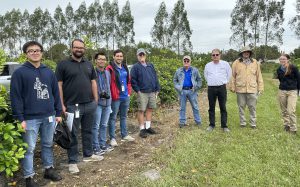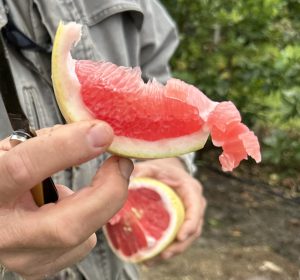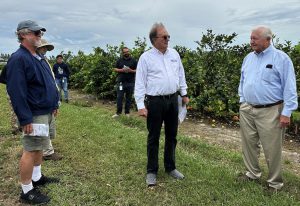FORT PIERCE, Fla.— Florida citrus producers, including corporate leaders and research scientists, gathered recently to tour a 20-acre experimental citrus grove to observe the disease tolerance and horticultural performance of more than 5,500 trees in Florida.
University of Florida research scientists will carry out the first harvest of the “Millennium Block,” a citrus grove planted in 2019 to help Florida growers decide which varieties to plant. The growers need trees that produce high-quality fresh fruit with tolerance of citrus greening and diaprepes root weevil.
Grower interest in new varieties
“Attendance at the annual field days is testimony to the interest and importance of these rootstock and scion trials to our stakeholders and fellow researchers,” said Ronald D. Cave, director of the UF/IFAS Indian River Research and Education Center (IRREC), in Fort Pierce, a 75-year-old research site at the center of the world’s renowned grapefruit production region. Cave is the lead investigator of the experiment.

Visitors from as far away as Sebring and Lake Alfred, Florida, drove through well-maintained rows of citrus trees marked with blue signs and tags coordinated with color-coded maps. Keys on the maps identified each rootstock and scion combination in replicated experimental plots.
The Millennium Block, testing ground for new varieties
Tom James, a UF/IFAS biological scientist at IRREC, said the grove is a good testing ground to identify the right combinations of new citrus rootstocks, the underground part of a tree, and scions, the aboveground fruit-bearing part. But he cautions that data are generally collected and analyzed for up to seven years before the researchers draw reliable scientific conclusions for the industry.

Still, interest in the ongoing observations of the trees is strong, and the anticipation of the first year of harvest data is high. There are 154 new citrus scion-rootstock combinations. Some will produce market-ready fruit. And some growers may want to make decisions based on the early data.
The grove features trials for navel oranges, mandarins, and grapefruit on numerous rootstocks, but the largest trial is for grapefruit and grapefruit-like scions, the crop in which visitors are most interested, said James.
“By years four, five, and six, we will have a much clearer understanding,” said James. The trial is now in its third year. And, the fruit they call grapefruit-like, or hybrids, produce healthful fruit that tastes good—even in mid-October.
In the grapefruit area, researchers from the UF/IFAS Citrus Research and Education Center examined the ‘UF 914’ scion, a grapefruit-like hybrid created by Professor of Horticulture and plant breeder Fred Gmitter. Gmitter explains that the fruit was developed without the chemicals that are responsible for the grapefruit-drug interactions, that discourage people taking various medications from enjoying grapefruit.
“The variety potentially could be marketed to consumers to safely consume grapefruit while using blood pressure or cholesterol control medications. Large scale clinical trials would be needed, however, for U.S. Food and Drug Administration to approve labeling the fruit variety as safe for the medication-niche-market consumers,” said Gmitter.

But Gmitter prefers to focus more on the eating quality of ‘UF 914’. “At its peak its taste is superior, according to taste testers in many different locations over the years,” said Gmitter. Gmitter added he was surprised to see that it is holding up well to greening, particularly on the X-639 rootstock. In fact, some of the best-looking trees in the trial are the ‘UF 914’-and X-639 combination.
The 914’s flesh is deep red, its rind is thick, and in the prime harvest months, February and March, the fruit is sweet and full of flavor equal to a grapefruit, said James.
“Grapefruit is susceptible to citrus greening,” said James. “The Indian River District produces premium grapefruit shipped to places worldwide, and it’s the variety growers in this area most want to grow.”
Among the rootstocks tested, sour orange rootstock was included because it is a traditional selection for the region, and some combinations with this rootstock are doing well in the grove, James said.
“The grove is in a high greening and diaprepes root weevil area,” said Pete Spyke, a longtime citrus producer and member of the IRREC Advisory Committee. Spyke advises university researchers for the work in the experimental grove.
“One of the things the researchers want is for the trees to become infected with greening at a very early age,” said Spyke. “We are not doing anything to prevent trees becoming infected with greening, just basic grove care.”
Three rootstocks in 1970s; to many more rootstocks to today
As recently as the 1970s, citrus production included only three predominant rootstocks. Cleopatra for mandarins; sour orange for fresh fruit and juice orange and grapefruit trees; and rough lemon for fruit primarily made into juice, most of which were Valencia oranges, Spyke said.
“The work put into the Millennium Block involves over 30 rootstocks,” said Spyke. “The assumption is that a few of them will eventually replace the traditional industry rootstocks. The rootstock portion of the trial is primarily designed to compare rootstocks in the UFR (‘University of Florida Rootstock’) group with other industry standard rootstocks. The Millennium Block is the most complete side-by-side UFR rootstock trial in Florida.”
Cave said the researchers will select from the experimental grove about five rootstocks that perform best in Florida citrus. The rootstocks chosen will work well in the local region but may not achieve the same in the state’s central or southwestern growing regions.

The future of Florida citrus production
Travis Murphy, a heritage citrus grower and IRREC Advisory Committee member, said a goal of the research is to use promising plant breeding results for new varieties and UFR rootstocks that better fit the current market.
“The new scion varieties being tested may produce fruit that is good for juice just like an “old” variety might on a new rootstock. The new varieties may also produce good fruit for juice in the old varieties as well as in new juice varieties,” said Murphy.
“Plant breeding work for new rootstocks and new varieties is more important today than when we were producing 244 million boxes of oranges in 1997. We never know what we will face with new diseases and pests, so the need for continuous plant breeding work and trials is more likely to grow even larger in the future,” said Murphy.
 20
20
